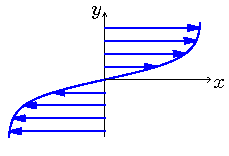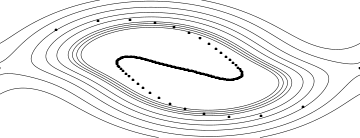
Kelvin-Helmholtz Instability in Fluid Mechanics
In an extension of the problem 3.2 of the Lecture Notes, one may study the stability of a monophasic shear flow, without interface. The basic flow has the following profile:


The state obtained, when the instability has well developed, is a `vortex street':


The `interface' between the fluid flowing to the right and the fluid flowing to the left has `rolled up' in the vortices. This `interface' may be, sometimes, visualized thanks to a cloud. That is, at least, what suggests the analogy between this computation and this photography by Brooks Martner, of the NOAA Environmental Technology Laboratory:

PLAUT, E. Mécanique des Fluides. Mines Nancy Lecture 2014.
|
Emmanuel Plaut |
Last modified: Tue Dec 22 10:40:18 CET 2015 |